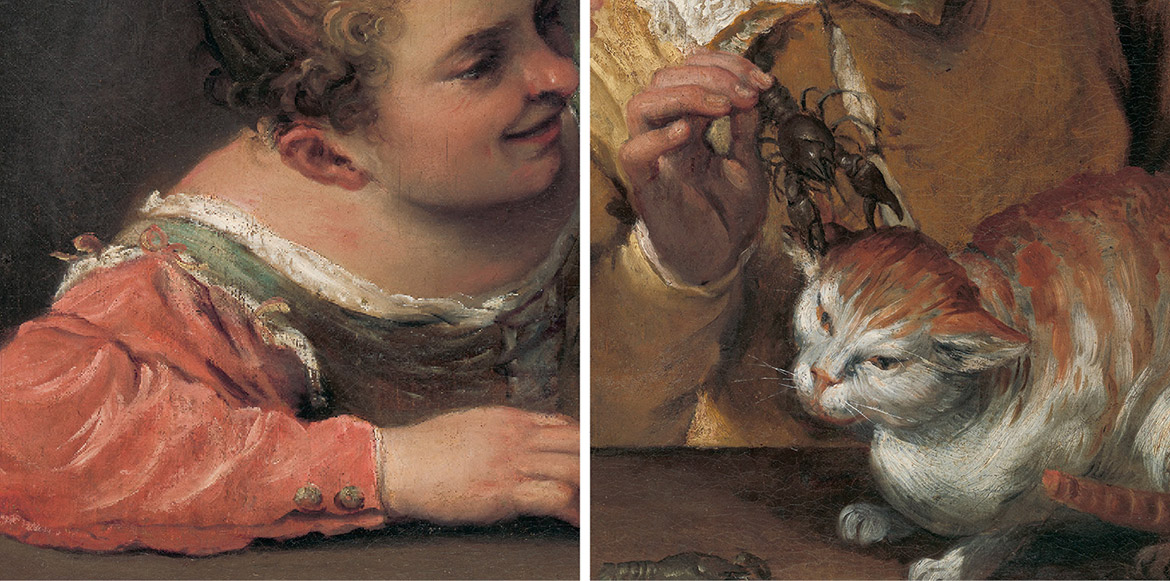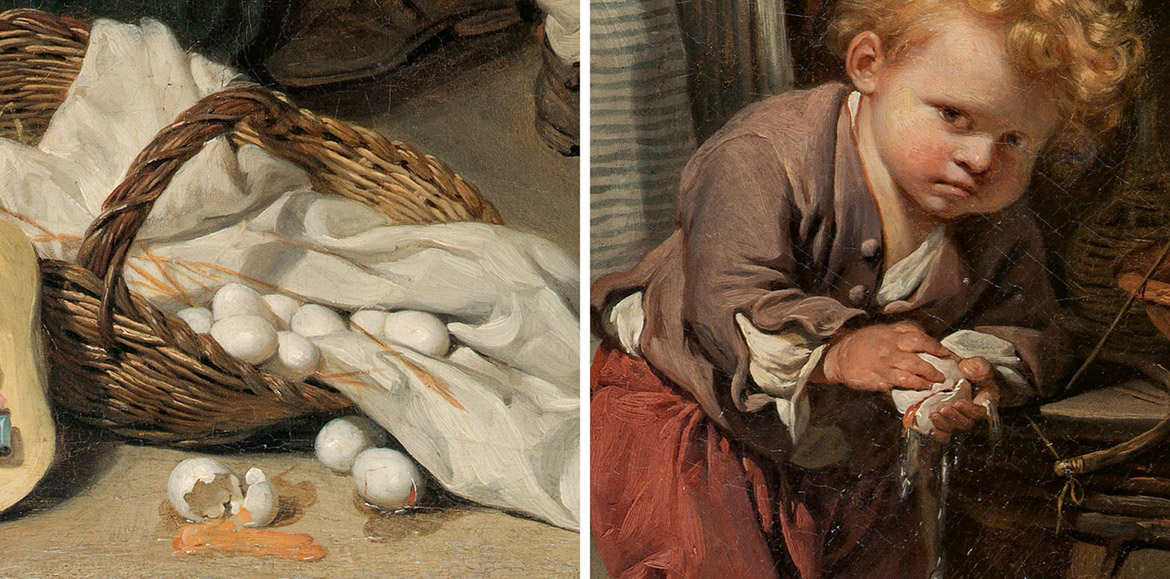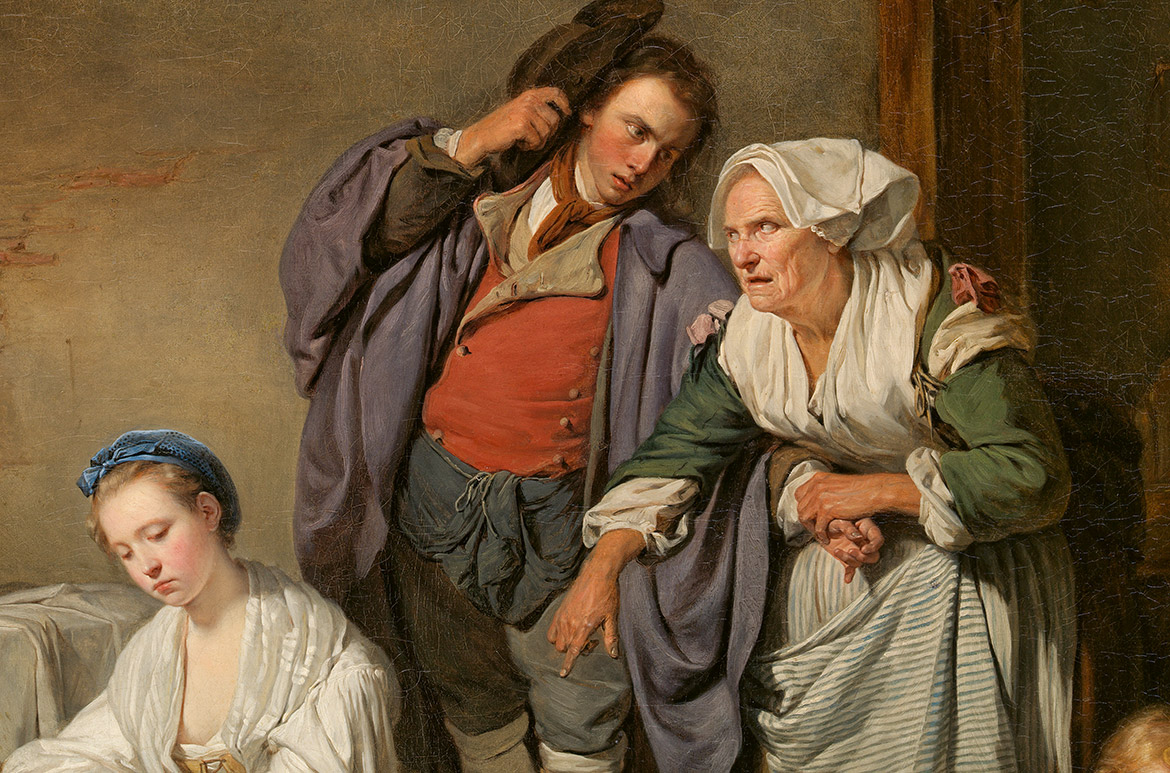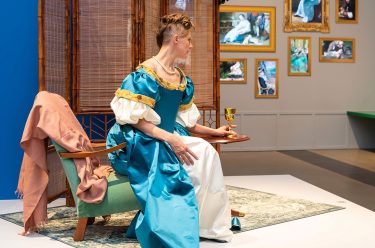One expects a certain level of seriousness from a masterpiece of art, and traditionally only religious and historical subjects were deemed suitable. However Two Children Teasing a Cat and Broken Eggs shows artists’ continuing captivation with the nuances of everyday life.
LIST OF WORKS: Discover all the artworks
DELVE DEEPER: More about the artists and exhibition
THE STUDIO: Artworks come to life
WATCH: The Met Curators highlight their favourite works
These two works, although painted some two centuries apart, provide a glimpse into a world that is very different, but also very much the same, as our own. The dreams and joys, and trials and tribulations of everyday life may be depicted according to their time, but they still ring true to our experiences today.
Annibale Carracci ‘Two Children Teasing a Cat’ c.1587–88

The Carraccis — Annibale, Agostino and their cousin Ludovico — founded a painting academy in Bologna, Italy, and were regarded as a vital force in the creation of the Italian Baroque. Annibale was innovative and radical for his introduction of new techniques to represent the effect of light on form, via ‘wet into wet’ brushwork made possible by oil paint. In addition to magnificent, frescoed ceilings featuring mythological subjects, he also reintroduced informal everyday genre scenes, capturing a snapshot moment of daily life.
Carracci’s paintings were revolutionary. He predominantly painted religious scenes, but he also had a sharply observant eye and a sense of humour, which he used to capture the world around him. His paintings of everyday life transformed Italian painting in the sixteenth century.
Two Children Teasing a Cat c.1587–88 which enjoyed considerable fame in its day, depicts two mischievous children teasing a cat with live crayfish, with the boy holding a crayfish pincers close to the cat’s ears, a girl, probably his younger sister, watches with rapt attention. Even if the cat appears unhappy, it tolerates the behaviour; although its posture indicates a reckoning might be imminent, the girl’s arm, resting a little too close.
Viewers are invited to imagine the result of teasing an obviously unhappy cat — you can almost hear its growl — for surely the little girl’s hand will be scratched, the artist invites the viewer to imagine the girl’s delight turning to tears. The painting incorporates a time factor and carries a lesson similar to the proverb to ‘Let sleeping dogs (or cats) lie’ — a narrative that unfolds in front of us in which the conclusion is implied, not depicted.
Two Children Teasing a Cat is among the earliest Italian genre paintings, painted with a directness and spontaneity with broken brushstrokes capturing movement and the effect of light, apparent on the girl’s sleeve and the boy’s shoulder. The red ribbon in the girl’s hair is merely suggested, and the cat is brushed so thinly as to appear almost unfinished.

Jean-Baptiste Greuze ‘Broken Eggs’ 1756

Broken Eggs 1756, a genre piece modelled on seventeenth-century Dutch painting, conveys a range of emotions, it is a puzzle for the viewer to decode, from the downcast look of the young girl and anger of the older woman being held back by a shame-faced young man, to the furtive secrecy of the young boy with golden curls.
Jean-Baptiste Greuze was an exceptional draftsman and portrait painter and he used symbolism to convey moral messages, he exhibited the painting at the Salon in 1757 with a statement indicating something of the relationship between each character: ‘A mother scolding a young man for having overturned a basket of eggs that her servant brought from the market. A child attempts to repair a broken egg.’ Scholars have speculated that Greuze intended to imply the loss of the servant girl’s virginity, symbolised by the broken eggs, and the dangers inherent in playing with Cupid’s darts (suggested by the child who leans on a small bow and arrow).
In Broken Eggs the darkened room’s interior highlights the drama played out by the characters within. The unhappy young girl, the older woman’s insistence that the young man acknowledge the broken eggs and in the foreground, a young child tries in innocence to repair the damage.
The animation of the characters enables us to immediately grasp the situation and the moral lesson intended. At the time, genre art was seen both as a powerful way to convey messages to those unable to read and to promote good social values.

This Australian-exclusive exhibition was at the Gallery of Modern Art from 12 June until 17 October 2021 and organised by The Metropolitan Museum of Art, New York, in collaboration with the Queensland Art Gallery | Gallery of Modern Art and Art Exhibitions Australia.
Featured image detail: Jean-Baptiste Greuze Broken Eggs 1756
#QAGOMA #TheMetGOMA


